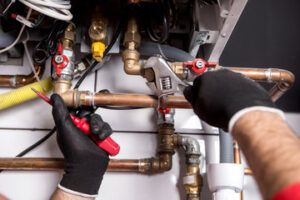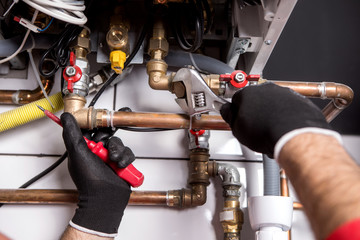Woodlands Plumbing are the system of pipes and fixtures that deliver potable water and remove wastewater. Plumbers install, repair, and maintain these systems in homes and businesses. They read blueprints and building codes to determine the layout of plumbing systems.
Residential and commercial plumbing systems are usually linked to city-managed water and sewer lines. This complex network of infrastructure carries sewage and waste to treatment plants.
A water heater is the appliance that heats up incoming cold water so your sinks, tubs, showers, and washing machines can produce warm or hot water for cleaning, washing clothes, cooking, and personal hygiene. Typically, this type of water heater is powered by natural gas, propane, oil, or electricity.
A traditional tank-style water heater has a dip tube that brings cold water into the tank, a heating burner or element inside that begins to heat up as it fills, and a thermostat to control the temperature of the water. The tank also has a drain valve on the bottom, a shut-off valve located outside and above the unit (to prevent water from flowing out of it), and a hot water supply port located at the top that allows the hottest water to exit the tank into the home’s plumbing system when you need it.
Over time, the sediment and minerals that make up your home’s water can cling to the inside of your water heater’s tank, wearing down its lining. This will eventually shorten the life of your water heater and cause it to leak or start to rust. To avoid this, a professional plumber can perform preventative maintenance on your water heater to clean out the sediment and minerals and keep it working properly.
During extreme temperatures, the pipes in your home can expand or contract, causing them to leak. One common sign of this is low water pressure in your hot and cold water faucets. A plumbing technician can test your water pressure to see if it’s coming from the water heater or if there are other issues affecting it.
Hot water lines
When water travels from the city main to your house, it passes through a water supply line or pipe. The supply line is buried underground so that it can’t freeze, and the pipe is typically made of copper, galvanized iron, or plastic. When the supply line enters your property, it splits into two different paths: one that supplies cold water to faucets and showers around your home, and the other that leads directly to your water heater. These two paths are commonly referred to as the “hot” and “cold” water lines.
Once the water gets to your house, it is pumped into the water heater, where it is heated. Once the water is ready, it moves out of your water heater into a series of hot water service lines that go to different rooms and appliances in your house. Ideally, these hot water pipes are sized properly for the number of fixtures they will supply. This allows the hot water to move quickly from the water heater to your faucets.
Unfortunately, these plumbing lines are also prone to problems related to temperature change and water inclusions (like dirt, debris, and minerals). If you have hard water, for example, that carries mineral buildup, these deposits can build up inside metal plumbing pipes and cause leaks and other damage.
Additionally, the chlorine and other chemicals that are used to treat your drinking water can corrode your plumbing pipes over time. The chlorine in the water turns into hypochlorous acid, which breaks down the carbon-to-carbon bonds in PPR pipes and weakens their structure, causing rusting and leaks. This problem is more common in hot water lines since the temperature of the water in these pipes is higher than in cold water lines.
Cold Water Lines
Water travels from your city’s water main to your house through a line that is buried underground. This pipe is typically made of galvanized iron, plastic, or copper. Once it gets inside your home, the main line splits into two different paths: hot and cold water lines. Each of these lines has its own metering device that tracks the amount of water you use.
The cold water line slopes away from your home’s water heater, and it branches off into all of your household’s faucets, showers, washing machines, and other appliances that require chilled water. Plumbers usually install these pipes at a 90-degree angle or slight downward slope to make it easier for the water to move through them.
Occasionally, it’s normal for a small portion of your cold water inlet pipe to feel hot. This is because the hot water from your water heater may be refluxing back up into the cold water line. However, if you notice that the entire inlet line feels hot, this is not a good sign and may indicate serious damage.
If your cold water line is feeling warm, it’s a good idea to call a professional plumber right away. They’ll be able to identify the issue and find an effective solution quickly. You can prevent future issues by upgrading to frost-free hose bibs and adding insulation to your exterior pipes. You can also work with a plumber to have them install pipe vents in your attic or crawlspace. These vents help your plumbing system operate properly. They also keep your indoor air temperature warmer, lowering the chance of freezing your outside lines. For the best results, choose a plumber who uses PEX or copper piping for both residential and commercial plumbing needs.
Drain Lines
In the plumbing industry, “drain lines” refer to any pipe that carries waste liquids or solids away from your toilets, sinks, showers, or tubs. These pipes connect to individual fixtures like garbage disposals and drain traps, and they empty into the sewer line or septic tank. If a drain line gets clogged, it can impact every fixture in your home. In addition, the clog can back up into your toilets and cause sewage to leak out of your shower or bathtub.
If you have a clogged drain, you may be tempted to use a store-bought chemical drain cleaner. However, these chemicals rarely dissolve blockages, and they may damage your plumbing pipes. A professional plumber can diagnose the issue, remove the clog, and repair your plumbing system.
Your main line is the large-diameter pipe that carries wastewater from all of your drains to your city connection or septic tank. Think of it as a major “sewer highway” into which all of the smaller drain roads (like your house’s drain lines) dump. When your main line is clogged, all of the waste from your toilets, sinks, and showers will be trapped in your home, causing your toilets to overflow and your bathtub and showers to fill with sewage.
The most common causes of clogged drains are hair, food scraps, and other solids that can’t break down in the water. In many homes, a clogged drain can be fixed by simply cleaning out the trap with a plunger or by removing the P-trap.
In multifamily buildings, you’ll want to periodically hand out pamphlets or notices that explain what can and cannot be poured down the drains. This will help prevent clogs and keep wastewater flowing properly throughout your building.
Sewer Lines
A sewer line is the pipe that carries all the waste and sewage from your home to either the city connection or your septic tank. Almost everything that goes down your drains, including the toilets, showers, sinks, and garbage disposal, goes through this main line. When this line becomes clogged, it can affect the entire house. Depending on the severity, you may even see sewage backing up through your toilets and other drains in the house.
If you suspect you have a sewer line issue, it is a good idea to contact a licensed plumber right away to schedule a camera inspection of the line. The technician can also let you know your options for repair or replacement of the line. Getting your sewer line replaced can be a huge project that usually needs to be done by professionals.
Some of the most common causes of a clogged sewer line are fats, oils, and grease that are sent down your drains. They will typically cool and harden in the lines, causing them to clog. Other common clog culprits include paper towels, so-called flushable wipes, and sanitary products that are tossed down the toilet. If you do find that your main line is clogged, the water will usually back up through the lowest point of entry into your home, which is typically a shower, tub, or floor drain in a basement.
Since most of the pipes that make up the sewer line are buried underground, there aren’t really any do-it-yourself ways to fix these issues. A professional plumber will need to handle this type of repair, which can be very expensive. If the plumber tries to clear the blockage by hand but the problem is too severe, it could require digging up the whole line and replacing it.
